BAE System Bundle
What Makes BAE Systems a Global Powerhouse?
Delve into the fascinating BAE System SWOT Analysis and uncover the story of BAE Systems, a titan in the defense and aerospace industry. From its roots in British Aerospace to its current global dominance, the company's journey is marked by strategic mergers and groundbreaking innovations. Discover how BAE Systems, with its rich history, has shaped the landscape of modern defense.
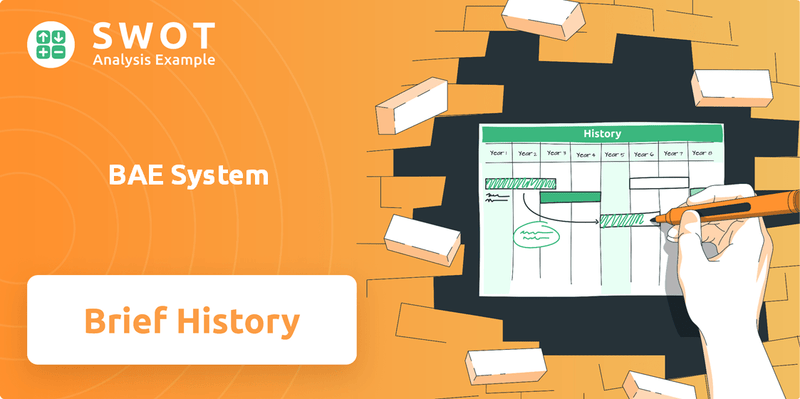
Tracing the BAE Systems history reveals a company built on strategic foresight and technological prowess. The merger that formed BAE Systems in 1999 was a pivotal moment, uniting British Aerospace and Marconi Electronic Systems to create a formidable force. Understanding the early years and significant milestones of BAE Systems provides crucial context for its present-day influence in the aerospace industry UK and beyond.
What is the BAE System Founding Story?
The story of BAE Systems begins on November 30, 1999. This marked the official formation of the company following a £7.7 billion merger. This merger brought together British Aerospace (BAe) and Marconi Electronic Systems (MES), creating a new force in the defense and aerospace industries.
This union was a strategic move to combine strengths. British Aerospace, known for its aircraft and military land systems, merged with Marconi Electronic Systems, the defense arm of GEC, which specialized in military systems. The goal was to create a more robust and globally competitive entity.
The merger of British Aerospace and Marconi Electronic Systems in 1999 created BAE Systems, a leading player in the global defense and aerospace market. The company's formation was driven by a strategic vision to consolidate British defense capabilities.
- British Aerospace (BAe): A key player in civil and military aircraft manufacturing, formed from the merger of BAC, Hawker Siddeley Group, and Scottish Aviation in 1977.
- Marconi Electronic Systems (MES): The defense division of GEC, with roots in Guglielmo Marconi's 1897 company, specializing in military systems integration.
- Merger Rationale: The merger aimed to create a more balanced portfolio and expand geographic reach, evolving from a UK-focused aircraft manufacturer to a global systems business.
- Product and Business Model: The initial offering was a comprehensive suite of defense and security solutions, including advanced electronics, cybersecurity, naval ships, and military aircraft.
The formation of BAE Systems was a strategic response to the evolving defense landscape. The merger aimed to create a company that could offer a wider range of products and services. The company's early focus was on designing, manufacturing, and supporting a broad spectrum of military and commercial products. This included advanced electronics, cybersecurity solutions, naval ships, submarines, and military aircraft. The Competitors Landscape of BAE System highlights the competitive environment BAE Systems operates in.
BAE System SWOT Analysis
- Complete SWOT Breakdown
- Fully Customizable
- Editable in Excel & Word
- Professional Formatting
- Investor-Ready Format
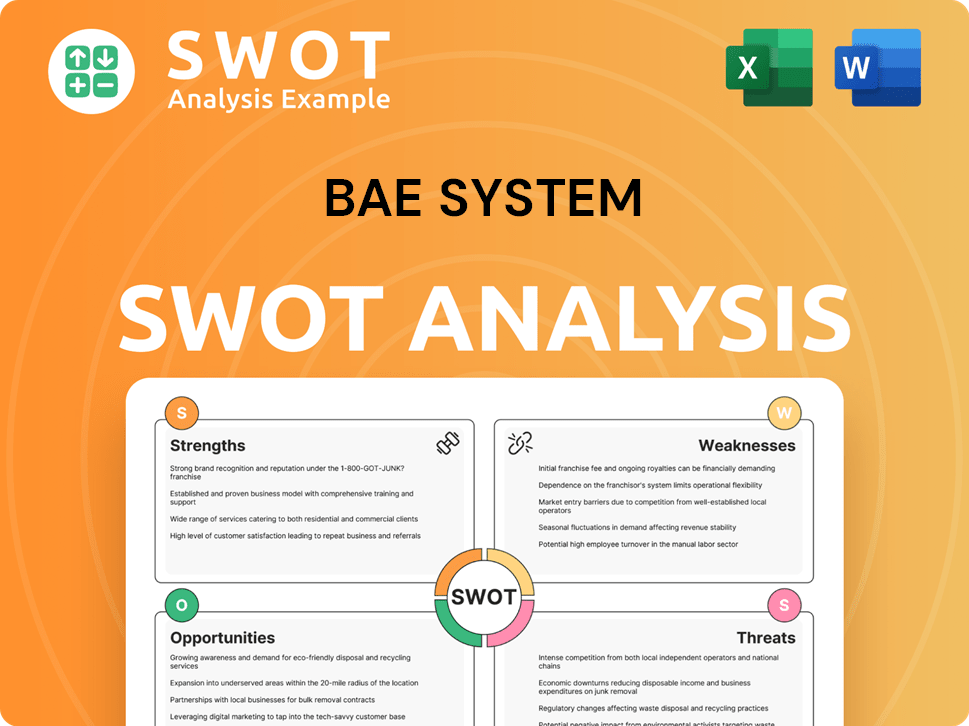
What Drove the Early Growth of BAE System?
Following its formation in 1999, BAE Systems history embarked on a path of growth, focusing on international markets. This involved strategic acquisitions and expansion into new product categories. These moves were crucial in shaping BAE Systems into a global leader in defense and security.
In April 2000, BAE Systems acquired Lockheed Martin Control Systems (LMCS) for US$510 million, later becoming BAE Systems Platform Solutions. In November 2000, they acquired Lockheed Martin Aerospace Electronic Systems, which included Sanders, Fairchild Systems, and Lockheed Martin Space Electronics & Communications, later known as BAE Systems Electronics & Integrated Solutions (E&IS). These acquisitions helped expand BAE Systems' capabilities in electronic controls, defense systems, and space electronics, establishing a strong presence in the U.S. defense market.
BAE Systems expanded its intelligence and security business with the purchase of Detica Group in July 2008 for £531 million. This strategic move strengthened its position in providing advanced technology solutions and services to governments and commercial clients. The acquisition of Detica Group enhanced BAE Systems' capabilities in cyber security, data analytics, and consulting services.
In 2008, BAE Systems significantly expanded its presence in Australia by acquiring Tenix Defence for A$775 million (£373 million). This acquisition made BAE Systems Australia the largest defense contractor in the country. The expansion in Australia was a key part of BAE Systems' strategy to increase its global footprint and diversify its revenue streams.
These early growth efforts, marked by strategic acquisitions, demonstrated BAE Systems' commitment to becoming a global leader. The company's focus on a diversified portfolio has been a key strategic shift. This approach ensured they addressed both immediate and evolving defense needs. These expansions have shaped BAE Systems into a multinational entity with a strong global presence.
BAE System PESTLE Analysis
- Covers All 6 PESTLE Categories
- No Research Needed – Save Hours of Work
- Built by Experts, Trusted by Consultants
- Instant Download, Ready to Use
- 100% Editable, Fully Customizable
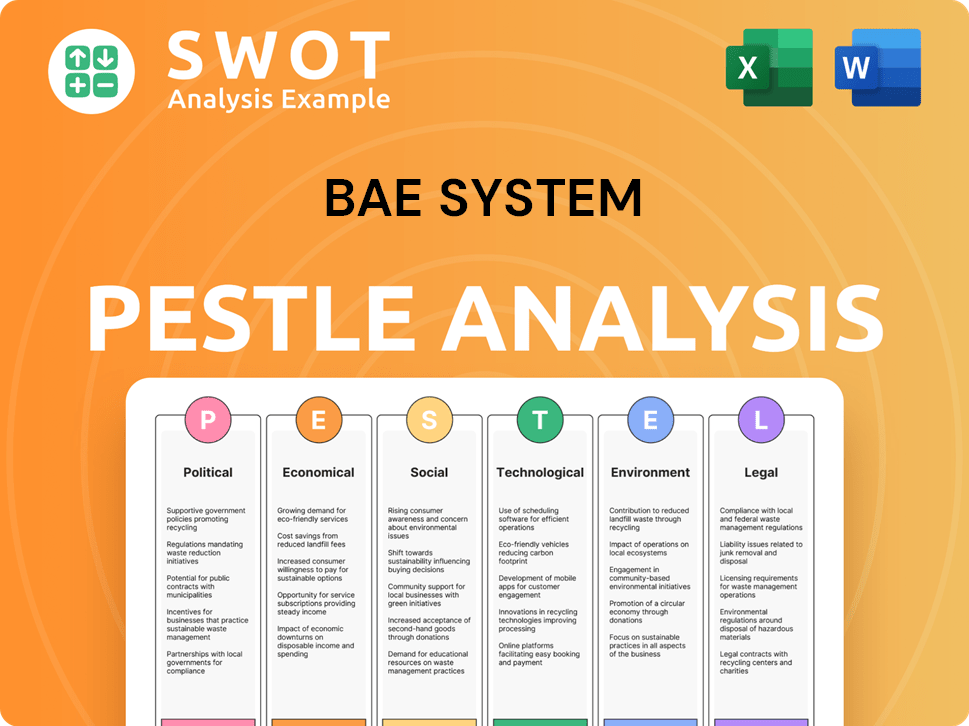
What are the key Milestones in BAE System history?
The BAE Systems history is marked by significant achievements and developments in the aerospace industry UK. The company's evolution has been shaped by strategic decisions, technological advancements, and its ability to adapt to the changing demands of the global defense market. BAE Systems has consistently demonstrated its commitment to innovation and its ability to secure major defense contracts.
| Year | Milestone |
|---|---|
| 1966 | Hawker Siddeley Aviation's Harrier vertical/short-takeoff-and-landing (V/STOL) fighter first flew. |
| October 2023 | Secured a £3.95 billion contract for development work on Aukus-class submarines, extending through 2028. |
| November 2024 | Awarded a five-year, $251 million contract by the U.S. Navy for the AEGIS Technical Representative (AEGIS TECHREP) organization. |
| June 2025 | Received a $1.2 billion contract from Space Systems Command to deliver 10 missile-tracking satellites for the Resilient Missile Warning Tracking program, with deliveries beginning in fiscal year 2029. |
| April 2025 | Secured a $70 million contract from General Dynamics Electric Boat to manufacture Virginia Payload Module (VPM) missile tubes for Block VI Virginia-class submarines. |
BAE Systems has consistently pushed the boundaries of technology, particularly in the defense sector. Their innovations have included significant contributions to programs like the F-35 Lightning II and the Eurofighter Typhoon.
The development of the Harrier, a groundbreaking vertical/short-takeoff-and-landing fighter aircraft, showcased early innovation.
BAE Systems is a key partner in the F-35 program, contributing advanced technologies and systems integration.
The company plays a crucial role in the Eurofighter Typhoon program, providing cutting-edge aerospace capabilities.
The acquisition of Ball Aerospace in February 2024 significantly expanded BAE Systems' presence in the space sector.
BAE Systems is involved in the development of Aukus-class submarines, showcasing its commitment to advanced defense projects.
BAE Systems received a $1.2 billion contract in June 2025 to deliver 10 missile-tracking satellites for the Resilient Missile Warning Tracking program.
Despite its successes, BAE Systems has faced challenges inherent in the defense industry. Market downturns and intense competition have necessitated strategic adjustments.
The defense industry is subject to fluctuating market conditions, requiring BAE Systems to adapt to changing demands and priorities.
BAE Systems faces strong competition from other major players in the global defense market, necessitating continuous innovation and efficiency improvements.
Strategic pivots, including restructuring and acquisitions like Ball Aerospace, have been crucial for maintaining competitiveness and expanding capabilities.
The company committed to a three-year share buyback program of up to £1.5 billion, which commenced in July 2024, with £392 million completed as of May 2025.
BAE Systems plans to recruit over 2,400 apprentices, undergraduates, and graduates in the UK in 2025, reflecting confidence in future growth.
The company invested a record amount in R&D and capital expenditure in 2024, demonstrating its commitment to innovation and growth.
BAE System Business Model Canvas
- Complete 9-Block Business Model Canvas
- Effortlessly Communicate Your Business Strategy
- Investor-Ready BMC Format
- 100% Editable and Customizable
- Clear and Structured Layout
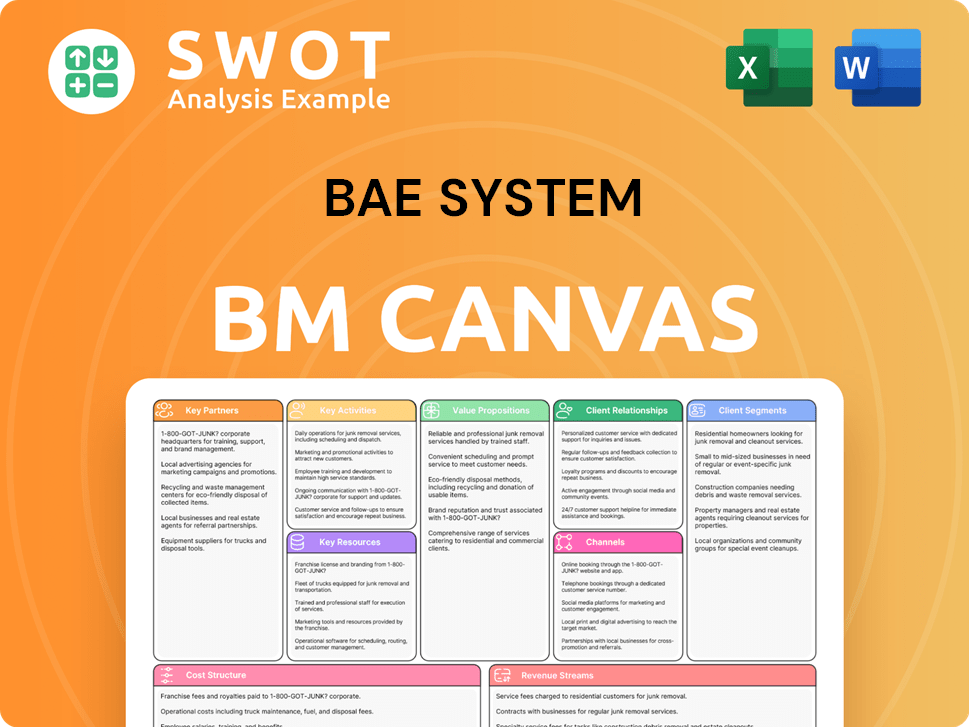
What is the Timeline of Key Events for BAE System?
The Company profile BAE Systems has a rich
BAE Systems history
, marked by significant milestones in the aerospace industry UK and the defense sector. From its early years as Hawker Siddeley Aviation to its current status as a global leader, the company has consistently adapted and evolved. Key figures and strategic mergers and acquisitions have shaped its trajectory, making it a major player in defense contracts and worldwide operations.| Year | Key Event |
|---|---|
| 1966 | Hawker Siddeley Aviation developed the Harrier, a pivotal aircraft. |
| 1977 | British Aerospace (BAe) was formed through nationalization and mergers. |
| 1979 | British Aerospace joined the Airbus Industrie consortium. |
| 1999 | BAE Systems plc was established through the merger of British Aerospace and Marconi Electronic Systems. |
| 2000 | BAE Systems acquired Lockheed Martin Control Systems. |
| 2008 | BAE Systems acquired Tenix Defence, becoming Australia's largest defense contractor. |
| 2008 | BAE Systems expanded its intelligence and security business with the purchase of Detica Group. |
| 2023 | BAE Systems opened an office in Ukraine and signed an agreement for cooperation on L119 howitzers. |
| 2023 | BAE Systems was awarded a £3.95 billion contract for development work on Aukus-class submarines. |
| 2024 | BAE Systems announced an initial agreement, potentially worth up to $50 million, to resume production of titanium structures for the M777 howitzer for the US Army. |
| 2024 | BAE Systems acquired Ball Aerospace for $5.5 billion (£4.4 billion). |
| 2024 | BAE Systems commenced a three-year share buyback program of up to £1.5 billion. |
| 2025 | Shareholders to receive the 2024 final dividend of 20.6p, payable on June 2, 2025. |
| 2025 | BAE Systems secured a $70 million contract for Virginia Payload Module missile tubes. |
| 2025 | BAE Systems reaffirms its full-year 2025 guidance, projecting sales growth of 7-9% to top £30 billion and underlying EBIT growth of 8-10%. |
| 2025 | Space Systems Command awards BAE Systems a $1.2 billion contract for 10 missile-tracking satellites. |
BAE Systems is positioned for continued growth. This is driven by the evolving defense and security landscape. Anticipated higher defense spending globally supports the company's strategic initiatives. They are focused on sustaining and expanding their core defense business.
BAE Systems is investing heavily in key technologies. These include electronic warfare, autonomy, and space solutions. Over £1.0 billion in capital expenditure in 2024 is aimed at increasing capacity. New facilities are expected to be operational by summer 2025.
Analysts predict a strong outlook for BAE Systems. The share price hit record levels in early June 2025. The company expects revenue to exceed £30 billion in 2025. This is driven by increased global defense spending and strategic government commitments.
The company is maintaining its guidance for the full year 2025. They are focused on delivering long-term program commitments. They are also investing to boost capacity and shape its portfolio for future growth. This strategy aligns with its vision of being a premier international defense company.
BAE System Porter's Five Forces Analysis
- Covers All 5 Competitive Forces in Detail
- Structured for Consultants, Students, and Founders
- 100% Editable in Microsoft Word & Excel
- Instant Digital Download – Use Immediately
- Compatible with Mac & PC – Fully Unlocked
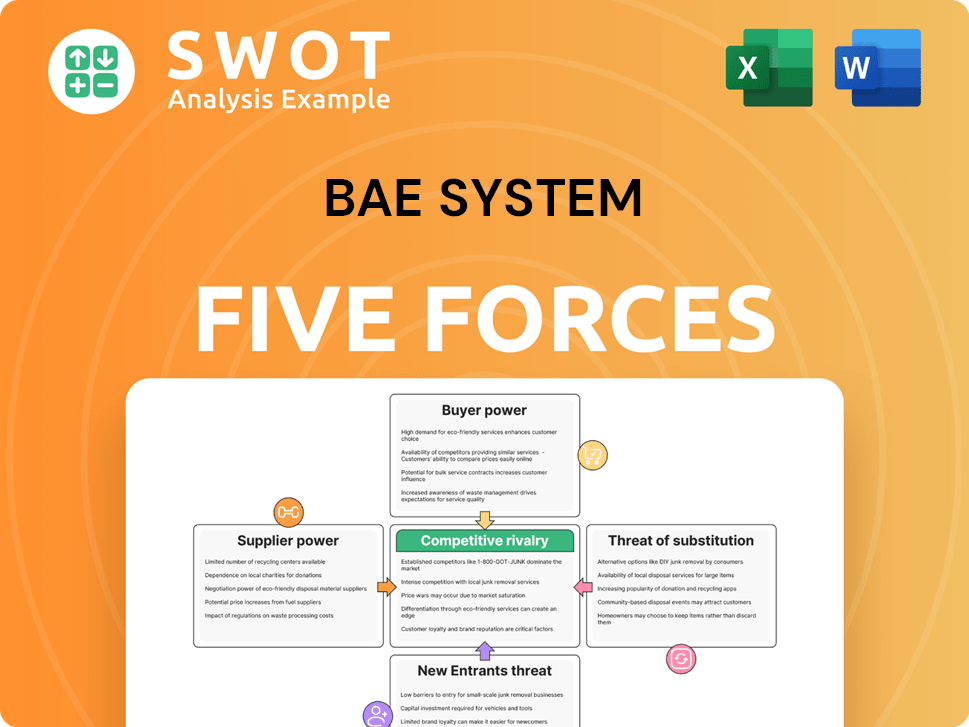
Related Blogs
- What is Competitive Landscape of BAE System Company?
- What is Growth Strategy and Future Prospects of BAE System Company?
- How Does BAE System Company Work?
- What is Sales and Marketing Strategy of BAE System Company?
- What is Brief History of BAE System Company?
- Who Owns BAE System Company?
- What is Customer Demographics and Target Market of BAE System Company?
Disclaimer
All information, articles, and product details provided on this website are for general informational and educational purposes only. We do not claim any ownership over, nor do we intend to infringe upon, any trademarks, copyrights, logos, brand names, or other intellectual property mentioned or depicted on this site. Such intellectual property remains the property of its respective owners, and any references here are made solely for identification or informational purposes, without implying any affiliation, endorsement, or partnership.
We make no representations or warranties, express or implied, regarding the accuracy, completeness, or suitability of any content or products presented. Nothing on this website should be construed as legal, tax, investment, financial, medical, or other professional advice. In addition, no part of this site—including articles or product references—constitutes a solicitation, recommendation, endorsement, advertisement, or offer to buy or sell any securities, franchises, or other financial instruments, particularly in jurisdictions where such activity would be unlawful.
All content is of a general nature and may not address the specific circumstances of any individual or entity. It is not a substitute for professional advice or services. Any actions you take based on the information provided here are strictly at your own risk. You accept full responsibility for any decisions or outcomes arising from your use of this website and agree to release us from any liability in connection with your use of, or reliance upon, the content or products found herein.